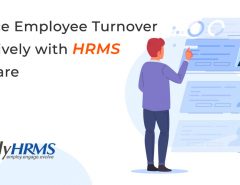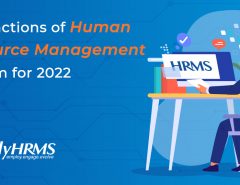Hundreds of applications flood the HR department’s mail inbox every day within a company. Ongoing recruitment of the correct talent is what helps companies flourish. Unfortunately, most organizations lose one-third of the new recruitments within the very first year. But retaining more employees is possible if companies run with a pompous employee onboarding process & dedicated budgets.
Employee onboarding to be a complete strategic process. It is not something that ends with the signing of all the paperwork by the employee on the first day. It is only the beginning where both the performance of the employee & employer is crucial for the first few days. The tidbits of the recruitment & employee onboarding process are elaborately explained in this informative blog content.
Understanding the Employee Onboarding Process:
Running a company includes functioning with several different ‘minds’ that think differently. So how can you ensure that your perspective & your employees’ perspective somewhere align? Alignment is necessary so that all can work collectively towards company goals. Emphasizing the recruitment & employee onboarding procedure can help attract like-minded individuals.
The employee onboarding procedure is an all-inclusive & systematic approach for incorporating new employees within an organization & its culture. It also includes offering the new hires important information & tools for bringing productivity in the various business operations. When the onboarding process is engaging & well-designed, its effect will be humongous on employee engagement & retention. The dated procedure of one-day orientation is no longer a choice. Onboarding is no longer a single event but is a constant talent strategy.
Importance of First Impressions for the Employee Onboarding Process:
Keeping in mind these stats is important for every company that decides to begin with their recruitment & employee onboarding process. By this, it is clear that a lack of clear guidance, ineffective training, or unfriendliness led to the quitting of employees. No organization can afford to run an ineffective onboarding procedure.
What are the objectives of the Employee Onboarding Process?
As per studies, 60% of new hires will continue working even four years later if the company followed a prearranged onboarding process.
Valuable employee onboarding programs enhance employee performance by 12%. The unrestricted efforts of employees have also been enhanced by 20% effective onboarding.
Teaching the company vision and values to new hires is important. But when the onboarding process is a clear one, employees can fully apprehend their roles. They must be able to relate to the company’s bigger picture operations. New employees can then learn to fulfil all expectations and also deliver tasks right on time.
As per a survey, almost 70% of companies with effective onboarding programs asserted a higher amount of successful assimilation of fresh recruits into the company culture. 65% of companies incurred better time to productivity ratios. 60% of other organizations reported more employee engagement.
Before the implementation of a proper employee onboarding process, every employer needs to answer a few key questions for establishing upper management & team buy-in.
The questions are:
- When will the onboarding process start?
- How long will the process last?
- What is the impression that the new employees must acquire by the day end of the first day?
- What do the recruits need to learn about the culture & work environment?
- What will be the role of HR in the process? Will it include an employee attendance system?
- Which goals do the new employees set?
- How will a company gather feedback on the employee onboarding program & how to measure the success?
Insightful tips on the Employee Onboarding Process:
- Offer a helping hand – The key to successful recruitment & employee onboarding program includes helping a new employee. You can help your new hires in the following ways:
Employees must come in aware of norms and values so that they understand the company’s position in the current marketplace. The first assignments of the employees must result in success. Constructing a network of sponsors & mentors is important. The advocates will help the new employees in various ways
The employees must receive encouragement for developing a growth mindset
- Beginning a day before the arrival of the new employees – This is one of the most vital rules that organizations must follow in context to onboarding:
An organization must remember that it is enlisting human beings who need to start working as fast as possible. This calls for an organized and prearranged employee onboarding.
Neither your nor the employees’ time must result in waste. An all-inclusive onboarding program incorporates a content structure that represents the company culture.
New hires must apprehend the organization’s tone internals to execute all tasks aptly.
- Onboarding & retention go arm-in-arm – Every organization’s definition of a perfect employee differs as per the particular role and industry. The onboarding process training must include clearly stated best practices, equipment, programs, and technology. Onboarding is never restricted to company policies, department introductions & facility tours.
Every year with advancements in technologies, fresh applications join the workforce. Along with this, the ways of guiding & retaining workers also transform.
So the top rules are:
- Onboarding is not similar to training
- Retention has an effect due to structured onboarding
- Training must incorporate the Why & How
- Talent Acquisition – Talent acquisition is not some selection exercise. This is a tactful people process for a company. A thoughtful procedure must include cautious job analysis, planned sourcing, buzz examination & cultural onboarding.
All the research done to date enables companies to know that, the effective onboarding process can actually break or make a new hire. This means a new employee can experience acclimation towards an organization in the preliminary 90 days.
But the onboarding process in the 21st century calls for immediate teams & managers to show care for the recruits not just resourcefully but personally also.
On a premeditated level, both parties can emphasize objectives & keep track of detailed orientation.
- Offering people the feeling of belonging – Most employees always feel enthusiastic about their new role in a new company. They will also feel like contributing quickly & would want to socialize with their colleagues. Company heads can achieve this by:
- Offering a social network for them to discover.
- Easy access to information & tools is important. One way of constructing a friction-free contribution is by permitting a new employee to start with their work.
- There must be an onboarding partner & his role will be to function solely with the new employee for the first three weeks. The partner can also be present later on but loosely.
- Role & importance of HR technology – Gone are those days when organizations used to carry out paper-based dated manual HR procedures. The capabilities that surround HR technology are huge amidst which attendance management is a highly important one. Enterprises can benefit in manifold ways with human resource management software. This kind of software automates the entirety of HR processes for enterprises. This not just incorporates onboarding but heightens employee engagement as well.
- Need for a plan, commitment & a checklist – 5% of new employees think of quitting after the very first day. 50% of them quit working within the first 4 months & 60% of externally recruited managers fail within the first 19 months of their work. By this, anyone can understand how important onboarding is. The three very critical rules encompassing onboarding process employees for successful integration within an organization are:
- A plan – The onboarding process experience needs to clearly communicate the role-based 7 organizational expectations to the employees. This calls for companies’ proper investment of time and resources so that the new hires make organizational & interpersonal connections for sheer success. To implement this strategic approach, HR professionals must deliver proper onboarding experiences & also offer support to the managers.
- 365 days commitment – Organizational integration is time-consuming. Understanding what an organization is about is linked to satisfaction, engagement & commitment. You can use milestones for the employees like 40, 70, 100 days on a job & till one year for facilitating experiences & check-in with new employees.
- Checklist – An onboarding strategy can be converted to reality with the company & job particular onboarding checklist. Every manager & new hire must understand their responsibility correct in the context of onboarding. Checklists that receive support from accompanying resources offers a clear roadmap to the entire onboarding journey. This guarantees a steadfast onboarding experience for every employee. When implemented well, a sound onboarding process leads to a speedier learning curve for the new hires. It also facilitates improved communication & an engaged workforce.
- Significance of a new team member – The first day for a new employee & a company is important. The organization must be prepared for this. This begins by realizing the importance of a new team member along with suitable introductions. It is important to ensure that the coworkers & leadership team members are familiar with the new hires. Making introductions early in the onboarding process is also very important. The workstation of the employee needs to be completely stocked. Phone and email accounts need to be set from prior.
- First impressions – Are you running your own company? If yes, you already know what effect recruitment & employee onboarding can put on your business growth. With the onboarding process, you get the ideal opportunity to create a lasting impression on a fresh recruit. They will always wish to feel as if the company they have selected is enthusiastic about their joining. The effect of a robust onboarding experience reaches far beyond the constructive impression. The employee can then understand their role & expectations in a better manner through this.
- Need for balance – Every organization has got just one chance for making a first impression. Onboarding employees is something that can break or make for fresh recruits. A balance needs to be set between an organized intention that offers critical information for preparing the employees for success and welcoming the new employees to an organization. This incorporates a structured prologue of relevant information and having the workers’ computer, passwords, workstation, phone all arranged from before. Little things matter a lot in the development of that first impression & companies receive a wonderful chance for beginning building retention from day 1 only.
- Vacuous roles do not simply affect productivity – The recruitment cost & time is taken for filling open vacancies are on the rise. Productivity does not get impacted just by unfulfilled roles but also negatively affects the morale of the employees especially the ones left for covering. Around one in four recruits leave their work within the primary six months. This in turn worsens pressures on engagement & cost. People can leave either if they are unhappy with their roles or if they feel they do not fit in ethnically.
A very important onboarding rule is to guarantee that the new hires exactly know what is anticipated out of them. They must also know how to be extremely productive. They must also feel an instant connection to their already present colleagues. This also means that the onboarding process is a way of integration that begins from the ultimate interview & not just an event that takes place on the first day.
Parting Thoughts:
A business takes shape & reaches success because of its people. Every enterprise that realizes this fact enjoys immeasurable growth. Taking note of approaches and tips by experts on the recruitment & employee onboarding process is important. Every new hire must have a clear vision of what shape their career will take in the upcoming few years. Transitioning the onboarding process into retention & employee satisfaction is the challenge that organizations need to crack. To learn more about exactllyHRMS, Contact Us today. Avail of Free Demo & let the HRMS software benefit your organization like never before.





Leave a Reply